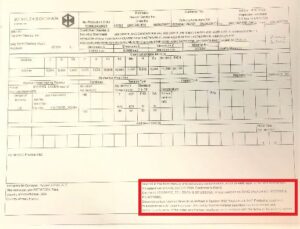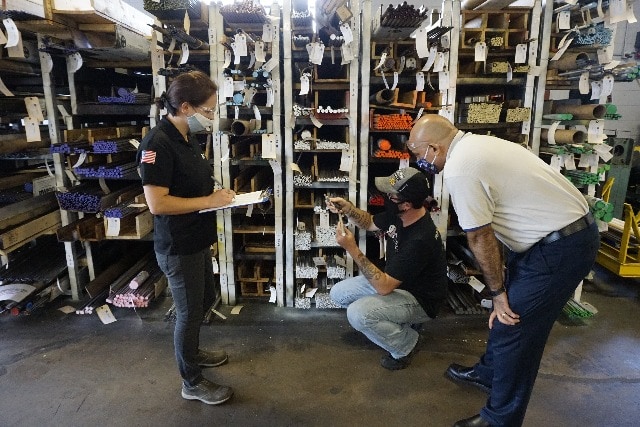“For machine shops like Pioneer Service, RoHS compliancy is often required by customers for the bar stock used to machine the components, as well as some finishing services like anodizing, plating, etc.” Karina Ramanauskas, Buyer and Planner at Pioneer Service. “Customer prints or purchase orders will state if this is required” Ramanauskas noted.
She went on to explain that “Pioneer Service has taken this a step further, and currently requires that all bar stock used in our production facility is RoHS compliant. Material Certifications from our vendors will include this information. Process Certifications may also be requested for some of our customer’s orders and we will include these with their shipment of components”.
What does RoHS mean, and what does it cover?
RoHS stands for Restriction of Hazardous Substances.
This initial Directive (RoHS 1) restricts the use of certain hazardous substances in the production of electronic equipment. It went into effect in 2003 in the European Union (EU) and is known as Directive 2002/95/EC. The hazardous substances covered include cadmium (Cd), lead (Pb), mercury (Hg), hexavalent chromium (CrVI), polybrominated biphenyls (PBB) and polybrominated diphenyl ethers (PBDE).
These substances have been found to be extremely hazardous to the environment and dangerous in terms of exposure during manufacturing and recycling. The goal is to limit their use and therefore the opportunity for them to end up in a landfill.
Any company going to sell or distribute household appliances, computers and communications devices, lighting, power tools, toys and gaming equipment and automatic dispensing machines in European Union countries are required to certify that the components used in their products are compliant with the RoHS directive.
RoHS 2 (Directive 2011/65/EU) went into effect in 2013 and requires additional record keeping from the entire supply chain. It also extends the range of electrical and electronic products covered to include cables and spare parts for these products, as well as medical products and control and monitoring devices. A company that is RoHS 2 compliant can apply for the CE marking directive.
RoHS 3 (Directive 2015/863) went into effect in 2019 and added 4 additional restricted substances (phthalates) to the original list, as part of the REACH legislation. These include butyl benzyl phthalate (BBP), di(2-ethylhexyl) phthalate (DEHP), dibutyl phthalate (DBP), and disobutyl phthalate (DIBP).
RoHS 5/6 refers to products that comply with 5 out of the original 6 hazardous substances (lead is exempted in this case).
Current discussions are underway to add additional hazardous substances to the list: Beryllium, Cobalt (dichloride and sulphate), Diantimony trioxide, Indium phosphide, Medium-Chain Chlorinated Paraffins (MCCPs), Nickel (sulphate and sulfamate), and Tetrabromobisphenol A (TBBP-A).
How does RoHS relate to REACH compliancy?
REACH stands for Registration, Evaluation, Authorization, Restriction of Chemicals. This regulation controls 197 hazardous substances of very high concern (SVHC). These additional chemicals are used to manufacture the products (like brackets, coatings, paints, etc). The 7 substances covered under RoHS are also on the REACH list.
How does it relate to Conflict Minerals?
RoHS compliance is often coupled with Conflict Minerals compliance. The conflict minerals covered under this directive include tantalum, tin, tungsten and gold. These minerals often originate from the Democratic Republic of Congo (DRC) and adjoining countries. The concern is that the sale of minerals from these areas are being used to help finance groups responsible for violence (conflict) in those countries. Under the Dodd-Frank Act of 2010, all publicly traded companies must report the origin of conflict minerals to the SEC.
Summary:
The need to be a good corporate citizen, and carefully consider the materials used in manufacturing continues to be an important topic for many industries. As consumer concern for the impacts on the health of the population and the planet continues to rise, the list of chemicals and substances on the RoHS and REACH lists will most likely continue to grow. Carefully abiding by the regulations put in place to help reduce the chances for injury and contamination should part of the strategic plan of every manufacturing organization.
Here is an example of a Material Certification showing RoHS compliancy in the lower right corner. Material certs are provided with all Pioneer Service customer orders.
For more information on Pioneer Service’s RoHS compliant materials, our CNC Swiss precision machining capabilities, CNC turning operations, or our AS9100 and ISO9001:2015 certification, please contact our team today!



